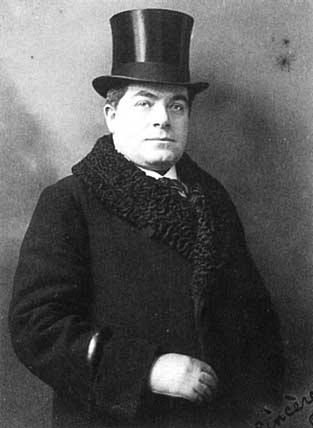Louis Goldsteen, one of the leading participants in the grand "World's Worst Tenor Contest", studied with various
teachers, first as a baritone, then as a tenor. From 1900, he regularly appeared in concert – on a semi-professional
level, since he also kept a typewriter and bicycle shop in Amsterdam together with his father-in-law. Singing was clearly his
second job: he appeared particularly often in charity concerts – in other words: he didn't need the money.
Around 1907/08, his appearances became more numerous and more prominent; although Jewish, he sang a lot of oratorio and masses.
His first documented opera performances followed in 1909: Erik in a concert performance in Hilversum on May 7th, and Walther
von der Vogelweide in a staged performance at the Amsterdam Stadsschouwburg on December 13th. In 1910, he was Pygmalion in
Suppé's Die schöne Galathee at the Stadsschouwburg and Don José at the Paleis voor Volksvlijt.
In October 1912, he became a member of the Théâtre Royal in Liège for one season (debut role: Lohengrin,
followed by &Eaccute;léazar). He called himself Louis Dornay now, and also made guest appearances at La Monnaie in
Brussels.
From autumn 1913, he lived in Berlin; he appeared again in concert, plus he sang opera in Aachen, Köln, Helsinki and Budapest.
When the First World War broke out, he returned to the Netherlands and joined the Théâtre Royal de La Haye (Den
Haag). Among the roles that he sang there were Raoul, Manrico, &Eaccute;léazar, Fernand, Radamès, Arnold, Vasco da Gama,
Duca and Gounod's Faust. After one season, his contract was not renewed, so he sang in concert again. In 1917, he sang a lot
at the Nederlandsche Opera in Amsterdam, and in winter 1917/18, he was back at the Théâtre Royal (meanwhile
renamed Opéra Royal Français) de La Haye, singing Jean, Samson, Faust, Turiddu, Arnold, Merlyn in De
Herbergsprinses by Jan Blockx and Duca.
In May and June 1920, he sang Tannhäuser, Canio and Don José with the Carl Rosa Opera Company in London; he
returned in October/November 1921 as Rodolfo, Canio and Pinkerton. Otherwise, he spent the years 1920 and 1921 in opera in
Amsterdam, Rotterdam and Den Haag.
At the end of 1921, he settled in the USA for four years; what he did there, apart from re-marrying and making a few records,
is not documented. Back to the Netherlands in autumn 1925, he sang Tannhäuser and Faust at the Co-Opera-Tie in Den Haag.
The first half of 1926, he was on a concert tour in (then Dutch) Indonesia. In August 1926, he moved to the US for good.
He continued to sing in concert and opera in Washington, Philadelphia, at Carnegie Hall or at the New York Hippodrome
(Tannhäuser, October 1933). New York was also where he and his wife, a pianist, opened the "Dornay Culp Studios", where
they taught, among many others, Dorothy Kirsten.
Reference 1, reference 2
Picture source: Dutch Divas
